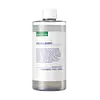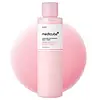What's inside
What's inside
 Key Ingredients
Key Ingredients

 Benefits
Benefits

 Concerns
Concerns

No concerns
 Ingredients Side-by-side
Ingredients Side-by-side

Water
Skin ConditioningButylene Glycol
HumectantGlycerin
HumectantPropanediol
SolventEuterpe Oleracea Fruit Extract
1,2-Hexanediol
Skin ConditioningProtease
ExfoliatingBetaine
HumectantPanthenol
Skin ConditioningRubus Fruticosus Fruit Extract
AstringentVaccinium Macrocarpon Fruit Extract
AstringentVaccinium Angustifolium Fruit Extract
Skin ProtectingRubus Idaeus Fruit Extract
AstringentSambucus Nigra Fruit Extract
AstringentXanthan Gum
EmulsifyingAllantoin
Skin ConditioningBeta-Glucan
Skin ConditioningFructan
Skin ConditioningStyrene/Vp Copolymer
Sodium Hyaluronate
HumectantPentylene Glycol
Skin ConditioningCaprylyl Glycol
EmollientWater, Butylene Glycol, Glycerin, Propanediol, Euterpe Oleracea Fruit Extract, 1,2-Hexanediol, Protease, Betaine, Panthenol, Rubus Fruticosus Fruit Extract, Vaccinium Macrocarpon Fruit Extract, Vaccinium Angustifolium Fruit Extract, Rubus Idaeus Fruit Extract, Sambucus Nigra Fruit Extract, Xanthan Gum, Allantoin, Beta-Glucan, Fructan, Styrene/Vp Copolymer, Sodium Hyaluronate, Pentylene Glycol, Caprylyl Glycol
Water
Skin ConditioningGlycerin
HumectantNiacinamide
SmoothingCetyl Ethylhexanoate
EmollientCaprylic/Capric Triglyceride
Masking1,2-Hexanediol
Skin ConditioningPentaerythrityl Tetraethylhexanoate
EmollientEthylhexyl Palmitate
EmollientPolyglyceryl-3 Distearate
EmulsifyingOctyldodecanol
EmollientDiisostearyl Malate
EmollientC12-14 Alketh-12
EmulsifyingAcrylates/C10-30 Alkyl Acrylate Crosspolymer
Emulsion StabilisingTromethamine
BufferingGlyceryl Stearate
EmollientEthylhexylglycerin
Skin ConditioningTrehalose
HumectantGlyceryl Stearate Citrate
EmollientAdenosine
Skin ConditioningDisodium EDTA
Cyanocobalamin
Skin ConditioningSaccharide Hydrolysate
HumectantOryza Sativa Bran Oil
EmollientOryza Sativa Bran Water
MaskingButylene Glycol
HumectantPrunus Amygdalus Amara Kernel Oil
MaskingCamellia Sinensis Leaf Extract
AntimicrobialPyrus Malus Leaf Extract
Skin ConditioningSorbitol
HumectantPanthenol
Skin ConditioningPropanediol
SolventVanilla Planifolia Fruit Extract
Skin ConditioningJasminum Officinale Flower Water
MaskingXylitylglucoside
HumectantAnhydroxylitol
HumectantHelianthus Annuus Seed Oil
EmollientDipropylene Glycol
HumectantSucrose Stearate
EmollientXylitol
HumectantBeta-Carotene
Skin ConditioningSodium Dna
Skin ConditioningPolyglyceryl-10 Oleate
Skin ConditioningVaccinium Myrtillus Fruit Extract
Skin ConditioningCentella Asiatica Root Extract
Skin ConditioningCentella Asiatica Leaf Extract
Skin ConditioningCentella Asiatica Extract
CleansingTocopherol
AntioxidantPueraria Lobata Root Extract
HumectantPentylene Glycol
Skin ConditioningMadecassoside
AntioxidantMilk Protein Extract
Lycopodium Clavatum Extract
Skin ConditioningEquisetum Arvense Extract
AstringentPhragmites Communis Extract
Skin ConditioningPrunus Amygdalus Dulcis Fruit Extract
Skin ConditioningLecithin
EmollientTremella Fuciformis Extract
HumectantTabebuia Impetiginosa Bark Extract
Skin ConditioningTrifolium Pratense Extract
Skin ConditioningAcetyl Glutamine
Skin ConditioningAsiatic Acid
Skin ConditioningBacillus/Soybean Ferment Extract
Skin ConditioningMadecassic Acid
Skin ConditioningAsiaticoside
AntioxidantHydrolyzed Wheat Protein
Skin ConditioningHydrolyzed Soy Protein
HumectantHydrolyzed Rice Protein
Skin ConditioningHydrolyzed Rice Bran Protein
Skin ConditioningHydrolyzed Corn Protein
Skin ConditioningCaprylyl Glycol
EmollientSodium Hyaluronate
HumectantFolic Acid
Skin ConditioningPalmitoyl Pentapeptide-4
Skin ConditioningCeramide Ns
Skin ConditioningCeramide NP
Skin ConditioningCeramide EOP
Skin ConditioningCeramide AP
Skin ConditioningOligopeptide-3
Skin ConditioningOligopeptide-2
Skin ConditioningOligopeptide-1
Skin ConditioningHexapeptide-11
Skin ConditioningWater, Glycerin, Niacinamide, Cetyl Ethylhexanoate, Caprylic/Capric Triglyceride, 1,2-Hexanediol, Pentaerythrityl Tetraethylhexanoate, Ethylhexyl Palmitate, Polyglyceryl-3 Distearate, Octyldodecanol, Diisostearyl Malate, C12-14 Alketh-12, Acrylates/C10-30 Alkyl Acrylate Crosspolymer, Tromethamine, Glyceryl Stearate, Ethylhexylglycerin, Trehalose, Glyceryl Stearate Citrate, Adenosine, Disodium EDTA, Cyanocobalamin, Saccharide Hydrolysate, Oryza Sativa Bran Oil, Oryza Sativa Bran Water, Butylene Glycol, Prunus Amygdalus Amara Kernel Oil, Camellia Sinensis Leaf Extract, Pyrus Malus Leaf Extract, Sorbitol, Panthenol, Propanediol, Vanilla Planifolia Fruit Extract, Jasminum Officinale Flower Water, Xylitylglucoside, Anhydroxylitol, Helianthus Annuus Seed Oil, Dipropylene Glycol, Sucrose Stearate, Xylitol, Beta-Carotene, Sodium Dna, Polyglyceryl-10 Oleate, Vaccinium Myrtillus Fruit Extract, Centella Asiatica Root Extract, Centella Asiatica Leaf Extract, Centella Asiatica Extract, Tocopherol, Pueraria Lobata Root Extract, Pentylene Glycol, Madecassoside, Milk Protein Extract, Lycopodium Clavatum Extract, Equisetum Arvense Extract, Phragmites Communis Extract, Prunus Amygdalus Dulcis Fruit Extract, Lecithin, Tremella Fuciformis Extract, Tabebuia Impetiginosa Bark Extract, Trifolium Pratense Extract, Acetyl Glutamine, Asiatic Acid, Bacillus/Soybean Ferment Extract, Madecassic Acid, Asiaticoside, Hydrolyzed Wheat Protein, Hydrolyzed Soy Protein, Hydrolyzed Rice Protein, Hydrolyzed Rice Bran Protein, Hydrolyzed Corn Protein, Caprylyl Glycol, Sodium Hyaluronate, Folic Acid, Palmitoyl Pentapeptide-4, Ceramide Ns, Ceramide NP, Ceramide EOP, Ceramide AP, Oligopeptide-3, Oligopeptide-2, Oligopeptide-1, Hexapeptide-11
 Reviews
Reviews

Ingredients Explained
These ingredients are found in both products.
Ingredients higher up in an ingredient list are typically present in a larger amount.
1,2-Hexanediol is a synthetic liquid and another multi-functional powerhouse.
It is a:
- Humectant, drawing moisture into the skin
- Emollient, helping to soften skin
- Solvent, dispersing and stabilizing formulas
- Preservative booster, enhancing the antimicrobial activity of other preservatives
Butylene Glycol (or BG) is used within cosmetic products for a few different reasons:
Overall, Butylene Glycol is a safe and well-rounded ingredient that works well with other ingredients.
Though this ingredient works well with most skin types, some people with sensitive skin may experience a reaction such as allergic rashes, closed comedones, or itchiness.
Learn more about Butylene GlycolCaprylyl Glycol is a humectant and emollient, meaning it attracts and preserves moisture.
It is a common ingredient in many products, especially those designed to hydrate skin. The primary benefits are retaining moisture, skin softening, and promoting a healthy skin barrier.
Though Caprylyl Glycol is an alcohol derived from fatty acids, it is not the kind that can dry out skin.
This ingredient is also used as a preservative to extend the life of products. It has slight antimicrobial properties.
Learn more about Caprylyl GlycolGlycerin is already naturally found in your skin. It helps moisturize and protect your skin.
A study from 2016 found glycerin to be more effective as a humectant than AHAs and hyaluronic acid.
As a humectant, it helps the skin stay hydrated by pulling moisture to your skin. The low molecular weight of glycerin allows it to pull moisture into the deeper layers of your skin.
Hydrated skin improves your skin barrier; Your skin barrier helps protect against irritants and bacteria.
Glycerin has also been found to have antimicrobial and antiviral properties. Due to these properties, glycerin is often used in wound and burn treatments.
In cosmetics, glycerin is usually derived from plants such as soybean or palm. However, it can also be sourced from animals, such as tallow or animal fat.
This ingredient is organic, colorless, odorless, and non-toxic.
Glycerin is the name for this ingredient in American English. British English uses Glycerol/Glycerine.
Learn more about GlycerinPanthenol is a common ingredient that helps hydrate and soothe the skin. It is found naturally in our skin and hair.
There are two forms of panthenol: D and L.
D-panthenol is also known as dexpanthenol. Most cosmetics use dexpanthenol or a mixture of D and L-panthenol.
Panthenol is famous due to its ability to go deeper into the skin's layers. Using this ingredient has numerous pros (and no cons):
Like hyaluronic acid, panthenol is a humectant. Humectants are able to bind and hold large amounts of water to keep skin hydrated.
This ingredient works well for wound healing. It works by increasing tissue in the wound and helps close open wounds.
Once oxidized, panthenol converts to pantothenic acid. Panthothenic acid is found in all living cells.
This ingredient is also referred to as pro-vitamin B5.
Learn more about PanthenolPentylene glycol is typically used within a product to thicken it. It also adds a smooth, soft, and moisturizing feel to the product. It is naturally found in plants such as sugar beets.
The hydrophilic trait of Pentylene Glycol makes it a humectant. As a humectant, Pentylene Glycol helps draw moisture from the air to your skin. This can help keep your skin hydrated.
This property also makes Pentylene Glycol a great texture enhancer. It can also help thicken or stabilize a product.
Pentylene Glycol also acts as a mild preservative and helps to keep a product microbe-free.
Some people may experience mild eye and skin irritation from Pentylene Glycol. We always recommend speaking with a professional about using this ingredient in your routine.
Pentylene Glycol has a low molecular weight and is part of the 1,2-glycol family.
Learn more about Pentylene GlycolPropanediol is an all-star ingredient. It softens, hydrates, and smooths the skin.
It’s often used to:
Propanediol is not likely to cause sensitivity and considered safe to use. It is derived from corn or petroleum with a clear color and no scent.
Learn more about PropanediolSodium Hyaluronate is hyaluronic acid's salt form. It is commonly derived from the sodium salt of hyaluronic acid.
Like hyaluronic acid, it is great at holding water and acts as a humectant. This makes it a great skin hydrating ingredient.
Sodium Hyaluronate is naturally occurring in our bodies and is mostly found in eye fluid and joints.
These are some other common types of Hyaluronic Acid:
Learn more about Sodium HyaluronateWater. It's the most common cosmetic ingredient of all. You'll usually see it at the top of ingredient lists, meaning that it makes up the largest part of the product.
So why is it so popular? Water most often acts as a solvent - this means that it helps dissolve other ingredients into the formulation.
You'll also recognize water as that liquid we all need to stay alive. If you see this, drink a glass of water. Stay hydrated!
Learn more about Water